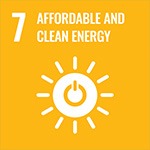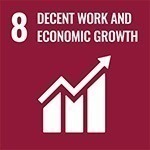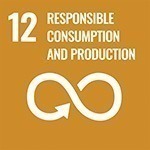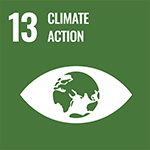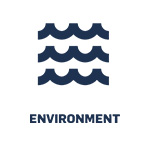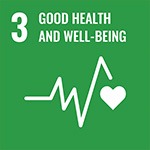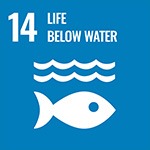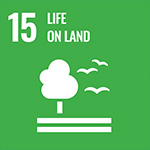Climate
Our operations strive to positively impact the climate.
Material Topics
Energy efficiency: (GRI disclosure: 302-1, 302-2, 302-3, 302-4, 302-5)
Efficient use of energy, prioritizing energy from clean (renewable) sources).
Climate changes: (GRI disclosure: 201-2, 305-1, 305-2, 305-3, 305-4, 305-5)
Planning, policies and actions to mitigate emissions, establish low carbon production and adapt to the scenario of a planet with a higher average temperature.
GRI 3-3(302) Management of the material topic Energy
Our mills are energy self-sufficient. The steam that powers the turbo generators for energy production is produced by the recovery boiler. This process is used at both our Bahia and our São Paulo mills.
We occasionally use electricity from the national grid during plant shutdowns for maintenance for example, in our forest areas and at our nurseries. Other fuels are consumed in energy generators in field operations.
At the São Paulo site, we have the Internal Energy Conservation Committee (CICE), that works to improve energy efficiency in our milling processes.
We invest in technologies to prioritize the use of renewable energy in our operations.
The two new flexible lines at the Lençóis Paulista (SP) site were built using the best technologies on the market and boast the most innovative solutions in the sector, according to a study conducted by an independent third party. This study had as its reference the document “Best Available Techniques (BAT) Reference Document for the Production of Pulp, Paper and Board, 2015”, adopted by the European Commission.
Our two lines are powered by on-site energy. Biomass-fueled boilers use eucalyptus waste and other substances from the dissolving pulp production process, including black liquor, to generate renewable electricity.
Bracell received the approval from the National Electric System Operator (ONS) and the National Electricity Regulatory Agency (Aneel) on December 31, 2021 to commence the commercial operation of its thermoelectric plant (440kV substation), with an installed capacity of 409,307MW, which generates clean, 100% renewable energy through turbo generators (TGs).
The energy generated is sufficient to meet the mill’s needs, and the surplus of between 150MW to 180MW is sold through the national grid. This green, high-quality electricity can supply power to 750,000 homes or around 3 million people.
The Bahia site also generates energy from renewable sources such as wood components and black liquor generated in the production of dissolving pulp. The energy generated powers the mill, and any surplus is sold. 3,212,967.94 GJ was sold in 2022.
GRI 302-1 Energy consumption within the organization
In 2022, our energy consumption totaled 7,290,122.60 GJ, with 456,500.52 GJ consisting of purchased energy. During the year, our energy generation totaled 10,159,338.27 GJ, and 3,212,967.94 GJ was sold.
| HISTORICAL ENERGY CONSUMPTION WITHIN THE ORGANIZATION ¹ (GJ) | |||
| 2020 | 20214 | 2022 | |
| Bahia2 | 1,577,624.40 | 1,561,586.40 | 1,574,003.78 |
| São Paulo | 657,466.56 | 3,260,816.99 | 5,715,726.82 |
| Mato Grosso do Sul 3 | 0.00 | 0.00 | 392.00 |
| Bracell | 2,235,090.96 | 4,822,403.39 | 7,290,122.60 |
1. The calculation considered the conversion of fuel consumption to GJ in accordance with the GHG Protocol. Data about electricity purchased from the grid includes electricity bill readings and does not include energy consumed within the mill. Reports from the mills and operational sites of the São Paulo plant, issued by the Company’s business area, were also taken into account. The conversion factors used are those of the GHG Protocol, IPCC, and National Energy Balance + MCTIC (Grid).
2. The total consumption of non-renewable fuel sources includes consumption of natural gas and liquefied petroleum gas (LPG). The total consumption of renewable sources includes black liquor.
3. Bracell only began operating in Mato Grosso do Sul in 2021. In this region, the Company only has forestry activities and no milling operation.
4. Correction of data reported in the 2021 Sustainability Report. GRI 2-4
| Generation output (GJ) | |||
| 2020 | 2021 | 2022 | |
| Bahia | 1,577,624.40 | 1.429.909.2 | 1,262,907.28 |
| São Paulo | 821,876.04 | 3,676,778.12 | 8,896,430.99 |
| Mato Grosso do Sul | 0.00 | 0.00 | 0,.00 |
| Bracell | 2,399,500.44 | 5,106,687.32 | 10,159,338.27 |
Note 1: Correction of data reported in the 2021 Sustainability Report. GRI 2-4
Note 2: In 2020, we reported our energy consumption in MWh. From 2021, we opted to present this information in GJ, the standard most frequently adopted for reporting this GRI content. GRI 2-4
| Purchased electricity (GJ) | |||
| 2020 | 2021 | 2022 | |
| Bahia | 142,970.40 | 204,426 | 348,790.00 |
| São Paulo | 13,854.60 | 1,217,805.82 | 117,746.00 |
| Mato Grosso do Sul | 0,00 | 0.00 | 150.00 |
| Bracell | 156,825.00 | 1,422,232 | 466,686.00 |
Note: Correction of data reported in the 2021 Sustainability Report. GRI 2-4
| Electricity sold (GJ) | |||
| 2020 | 2021 | 2022 | |
| Bahia | 76,406.40 | 72,745.2 | 32,263.77 |
| São Paulo | 175.947.12 | 473,077.97 | 3,180,704.16 |
| Mato Grosso do Sul | 0.00 | 0.00 | 0.00 |
| Bracell | 252,353.52 | 545,823.17 | 3,212,967.94 |
GRI 302-2 Energy consumption outside the organization
The energy consumption outside the organization was 466.686 GJ in 2022.
| Operation | GJ |
| São Paulo | 117,746 |
| Mato Grosso do Sul | 150 |
| Bahia | 348,790 |
| Total | 466,686 |
GRI 302-3 Energy intensity
In 2022, the energy intensity of Bahia’s mill operation was 3.27 GJ/tsa. The value considers the total production of 480,777 metric tons of pulp in the year. Only the electricity consumption of the industrial area itself was considered in the calculation.
The São Paulo operation did not consume energy from the GRID in 2022 because it generated the energy consumed in the industrial operation.
GRI 302-4 Reduction of energy consumption
In Bahia’s mill operation we had a reduction in the consumption of fossil fuels: we reduced natural gas consumption by 9.5%. In the São Paulo operations, the new flexible lines began operating in September 2021, so we do not yet have a database for comparing consumption reduction.
GRI 302-5 Reductions in energy requirements of products and services
In Bahia’s mill operation we had a reduction in the consumption of fossil fuels: we reduced natural gas consumption by 9.5%. In the São Paulo operations, the new flexible lines began operating in September 2021, so we do not yet have a database for comparing consumption reduction.
GRI 201-2 Financial implications and other risks and opportunities due to climate change
Bracell considers climate-change risks and opportunities in its strategic planning, and implements measures to ensure the medium- and long-term sustainability of the company and its operations and activities.
The Climate pillar is part of the Sustainability Strategy, whose scope monitors these and other material issues. The climate-related targets plan is currently under development, as part of Bracell long-term socio-environmental goals (read more in the Sustainability Strategy item).
We develop operational solutions based on the circular bioeconomy. Our operations pursue the efficient use of water and energy, monitor the quality of our effluents and sub-drainage basins and conduct climate zoning studies evaluating indicators such as rainfall, with the aim of hosting our eucalyptus plantations in regions with higher rainfall levels.
We also have policies and procedures to preserve and foster ecosystem biodiversity in our geographies. These are vital topics, intimately connected to the Climate agenda, and are priorities for Bracell (see more in the Responsible Production, Biodiversity and Landscapes sections).
GRI 3-3 (305) Management of the material topic Climate Change
Our operations strive to positively impact the climate.
Aligned with the Paris Agreement, we have adopted measures aimed at helping limit the global average temperature increase to within 2°C compared to pre-industrial levels. We also invest in initiatives that endeavor to limit this increase to 1.5°C compared to pre-industrial levels.
We develop operational solutions based on the circular bioeconomy. Our operations pursue the efficient use of water and energy, monitor the quality of our effluents and sub-drainage basins and conduct climate zoning studies evaluating indicators such as rainfall, with the aim of hosting our eucalyptus plantations in regions with higher rainfall levels. We also have policies and procedures to preserve and foster ecosystem biodiversity in our geographies. These are vital topics, intimately connected to the Climate agenda, and are priorities for Bracell (see more in the Responsible Production, Biodiversity and Thriving Landscapes sections).
Climate forms one of the pillars of our Sustainability Strategy. Our materiality study consulted strategic stakeholders and identified the following topics as priorities:
Climate change
Planning, policies, and initiatives to mitigate emissions, establishing low-carbon production and adapting to a warmer planet.
Energy efficiency
Efficient use of energy, prioritizing clean (renewable) sources.
The practices presented below address these priorities.
Our mills are energy self-sufficient
The steam that powers the turbo generators for energy production is produced by the recovery boiler. This process is used at both our Bahia and our São Paulo mills.
We occasionally use electricity from the national grid during plant shutdowns for maintenance for example, in our forest areas and at our nurseries. Other fuels are consumed in energy generators in field operations.
At the São Paulo site, we have the Internal Energy Conservation Committee (CICE), that works to improve energy efficiency in our milling processes.
In 2022, energy consumption totaled 7,290,122.60 GJ, with 456,500.52 GJ consisting of purchased energy. During the year, our energy generation totaled 10,159,338.27 GJ, and 3,212,967.94 GJ was sold.
Renewable energy generation and trading
We invest in technologies to prioritize the use of renewable energy in our operations.
The two new flexible lines at the Lençóis Paulista (SP) site were built using the best technologies on the market and boast the most innovative solutions in the sector, according to a study conducted by an independent third party. This study had as its reference the document “Best Available Techniques (BAT) Reference Document for the Production of Pulp, Paper and Board, 2015”, adopted by the European Commission.
Our two lines are powered by on-site energy. Biomass-fueled boilers use eucalyptus waste and other substances from the dissolving pulp production process, including black liquor, to generate renewable electricity.
Bracell received the approval from the National Electric System Operator (ONS) and the National Electricity Regulatory Agency (Aneel) on December 31, 2021 to commence the commercial operation of its thermoelectric plant (440kV substation), with an installed capacity of 409,307MW, which generates clean, 100% renewable energy through turbo generators (TGs).
The energy generated is sufficient to fill the mill’s needs, and the surplus of between 150MW to 180MW is sold through the national grid. This green, high-quality electricity can supply power to 750,000 homes or around 3 million people.
The Bahia site also generates energy from renewable sources such as wood components and black liquor generated in the production of dissolving pulp. The energy generated powers the mill, and any surplus is sold. 3,212,967.94 GJ was sold in 2022.
| Cooperative Program on Eucalyptus Productivity and Carbon and Water Flows (EUCFLUX)
Bracell, represented by the R&D Department, is part of the Eucflux-IPEF Cooperative Program, which monitors carbon flux and water in eucalyptus plantations. The flow tower with the equipment that monitors these components is situated in an eucalyptus plantation area, part of Bracell operations, in the municipality of Itatinga (SP). The Program is led by IPEF (Institute of Forestry Research and Studies) and CIRAD (French Agricultural Research Centre for International Development), and was started in 2007. It has several affiliated companies from the pulp sector, including Bracell, and representative institutions from academia, such as the Federal University of Lavras, UNESP (Paulista State University) and the University of São Paulo (Esalq). Bracell has been part of the EUCFLUX project since phase 1 and now, with the tower in one of its forestry production areas, has generated important information for forestry management and for the understanding of the carbon cycle in a eucalyptus forest. Due to the importance of this theme, in 2022 Bracell developed a roadmap to evolve knowledge and a solid and quality scientific base in this subject. Due to the importance of this topic, in 2022, Bracell developed a plan to carry out new research projects and evolve knowledge in this subject. In the coming years, we will invest even more in towers for this purpose, also focusing on native forests situated throughout the company operations area. |
GRI 305-1 Direct (Scope 1) GHG emissions
We closed the year with 43,389,968 tCO2e of carbon stock in forest areas (eucalyptus plantations and areas of native vegetation set aside for conservation), which have a fundamental role in removing CO2 from the atmosphere.
| Carbon stocks in forestry areas (tCO2e) | |
| Stock in planted forestry areas | 32,540,594.219 tCO2e |
| Stock in areas of native vegetation | 10,849,374.147 tCO2e |
| Total forest carbon stock | 43,389,968.366 tCO2e |
In 2022, our carbon balance was 4,039,103 tCO2e. During the year, our direct emissions accounted for 614,673 tCO2e (Scope 1) and 5,258 tCO2e (Scope 2).
The indirect emissions (Scope 3) totaled 935,183 tCO2e (read more about our carbon inventory in GRI Content 305-5), with the largest volume of emissions corresponding to to the increase in pulp exports (T&D Downstream – Scope 3), which totaled 789,886 tCO2e for the year.
The increase in emissions compared to 2021 is mainly the consequence of the increase in volume of pulp production after the the startup of operations of the two new flexible lines at the Lençóis Paulista (SP) site.
Considering our operations in Bahia and São Paulo, we have, since September 2021, installed capacity to produce 2 million metric tons of dissolving pulp per year, or up to 3 million metric tons of Kraft pulp per year.
In 2022, we set a record in the production of dissolving pulp in Bahia. We produced 480,777 metric tons.
| CARBON BALANCE (tCO2e)1, 2
GRI 305-1, 305-2, 305-3 |
|||
| Emissions | 2020 | 2021 | 2022 |
| Total (S1 + S2 + S3) | 342,384 | 636,549 | 1,555,114 |
| Scope 1 | 339,032 | 365,172 | 614,673 |
| Scope 2 | 3,352 | 35,283 | 5,258 |
| Scope 3 | Not accounted | 236,094 | 935,183 |
| Biogenic emissions LULUCF | 0 | 0 | 3,793,8314 |
| Removals | -4,401,975 | -5,970,852 | -1,309,8423 |
| Balance | -4,059,5915 | -5,334,303 | 4,039,103 |
- The Balance calculation includes – Scope 1 + Scope 2 + Scope 3 + Biogenic emissions LULUCF – Removals.
- In compliance with the Brazilian GHG Protocol Programme and the Brazilian Technical Standards Association ISO 14064 standard.
- Biogenic removals LULUCF.
- Biogenic emissions LULUCF: in our scope, represents the biogenic emissions from forestry management, such as harvesting of eucalyptus plantations.
- Rectification of the amount reported in the 2021 and 2020 reporting cycles. GRI 2-4.
GRI 305-2 Energy indirect (Scope 2) GHG emissions
We closed the year with 43,389,968 tCO2e of carbon stock in forest areas (eucalyptus plantations and areas of native vegetation set aside for conservation), which have a fundamental role in removing CO2 from the atmosphere.
| Carbon stocks in forestry areas (tCO2e) | |
| Stock in planted forestry areas | 32,540,594.219 tCO2e |
| Stock in areas of native vegetation | 10,849,374.147 tCO2e |
| Total forest carbon stock | 43,389,968.366 tCO2e |
In 2022, our carbon balance was 4,039,103 tCO2e. During the year, our direct emissions accounted for 614,673 tCO2e (Scope 1) and 5,258 tCO2e (Scope 2).
The indirect emissions (Scope 3) totaled 935,183 tCO2e (read more about our carbon inventory in GRI Content 305-5), with the largest volume of emissions corresponding to to the increase in pulp exports (T&D Downstream – Scope 3), which totaled 789,886 tCO2e for the year.
The increase in emissions compared to 2021 is mainly the consequence of the increase in volume of pulp production after the the startup of operations of the two new flexible lines at the Lençóis Paulista (SP) site.
Considering our operations in Bahia and São Paulo, we have, since September 2021, installed capacity to produce 2 million metric tons of dissolving pulp per year, or up to 3 million metric tons of Kraft pulp per year.
In 2022, we set a record in the production of dissolving pulp in Bahia. We produced 480,777 metric tons.
| CARBON BALANCE (tCO2e)1, 2
GRI 305-1, 305-2, 305-3 |
|||
| Emissions | 2020 | 2021 | 2022 |
| Total (S1 + S2 + S3) | 342,384 | 636,549 | 1,555,114 |
| Scope 1 | 339,032 | 365,172 | 614,673 |
| Scope 2 | 3,352 | 35,283 | 5,258 |
| Scope 3 | Not accounted | 236,094 | 935,183 |
| Biogenic emissions LULUCF | 0 | 0 | 3,793,8314 |
| Removals | -4,401,975 | -5,970,852 | -1,309,8423 |
| Balance | -4,059,5915 | -5,334,303 | 4,039,103 |
- The Balance calculation includes – Scope 1 + Scope 2 + Scope 3 + Biogenic emissions LULUCF – Removals.
- In compliance with the Brazilian GHG Protocol Programme and the Brazilian Technical Standards Association ISO 14064 standard.
- Biogenic removals LULUCF.
- Biogenic emissions LULUCF: in our scope, represents the biogenic emissions from forestry management, such as harvesting of eucalyptus plantations.
- Rectification of the amount reported in the 2021 and 2020 reporting cycles. GRI 2-4.
GRI 305-3 Other indirect (Scope 3) GHG emissions
We closed the year with 43,389,968 tCO2e of carbon stock in forest areas (eucalyptus plantations and areas of native vegetation set aside for conservation), which have a fundamental role in removing CO2 from the atmosphere.
| Carbon stocks in forestry areas (tCO2e) | |
| Stock in planted forestry areas | 32,540,594.219 tCO2e |
| Stock in areas of native vegetation | 10,849,374.147 tCO2e |
| Total forest carbon stock | 43,389,968.366 tCO2e |
In 2022, our carbon balance was 4,039,103 tCO2e. During the year, our direct emissions accounted for 614,673 tCO2e (Scope 1) and 5,258 tCO2e (Scope 2).
The indirect emissions (Scope 3) totaled 935,183 tCO2e (read more about our carbon inventory in GRI Content 305-5), with the largest volume of emissions corresponding to to the increase in pulp exports (T&D Downstream – Scope 3), which totaled 789,886 tCO2e for the year.
The increase in emissions compared to 2021 is mainly the consequence of the increase in volume of pulp production after the the startup of operations of the two new flexible lines at the Lençóis Paulista (SP) site.
Considering our operations in Bahia and São Paulo, we have, since September 2021, installed capacity to produce 2 million metric tons of dissolving pulp per year, or up to 3 million metric tons of Kraft pulp per year.
In 2022, we set a record in the production of dissolving pulp in Bahia. We produced 480,777 metric tons.
| CARBON BALANCE (tCO2e)1, 2
GRI 305-1, 305-2, 305-3 |
|||
| Emissions | 2020 | 2021 | 2022 |
| Total (S1 + S2 + S3) | 342,384 | 636,549 | 1,555,114 |
| Scope 1 | 339,032 | 365,172 | 614,673 |
| Scope 2 | 3,352 | 35,283 | 5,258 |
| Scope 3 | Not accounted | 236,094 | 935,183 |
| Biogenic emissions LULUCF | 0 | 0 | 3,793,8314 |
| Removals | -4,401,975 | -5,970,852 | -1,309,8423 |
| Balance | -4,059,5915 | -5,334,303 | 4,039,103 |
- The Balance calculation includes – Scope 1 + Scope 2 + Scope 3 + Biogenic emissions LULUCF – Removals.
- In compliance with the Brazilian GHG Protocol Programme and the Brazilian Technical Standards Association ISO 14064 standard.
- Biogenic removals LULUCF.
- Biogenic emissions LULUCF: in our scope, represents the biogenic emissions from forestry management, such as harvesting of eucalyptus plantations.
- Rectification of the amount reported in the 2021 and 2020 reporting cycles. GRI 2-4.
GRI 305-4 GHG emissions intensity
We reduced emissions (Scope 1, 2 and 3) by 8% per ton of pulp, in 2022.
| Emissions | 2022
(tCO2e/ton) |
| Scope 1, 2 and 3 | 0.4932 |
GRI 305-5 Reduction GHG emissions
We closed the year with 43,389,968 tCO2e of carbon stock in forest areas (eucalyptus plantations and areas of native vegetation set aside for conservation), which have a fundamental role in removing CO2 from the atmosphere.
| Carbon stocks in forestry areas (tCO2e) | |
| Stock in planted forestry areas | 32,540,594.219 tCO2e |
| Stock in areas of native vegetation | 10,849,374.147 tCO2e |
| Total forest carbon stock | 43,389,968.366 tCO2e |
In 2022, our carbon balance was 4,039,103 tCO2e. During the year, our direct emissions accounted for 614,673 tCO2e (Scope 1) and 5,258 tCO2e (Scope 2).
The indirect emissions (Scope 3) totaled 935,183 tCO2e (read more about our carbon inventory in GRI Content 305-5), with the largest volume of emissions corresponding to to the increase in pulp exports (T&D Downstream – Scope 3), which totaled 789,886 tCO2e for the year.
The increase in emissions compared to 2021 is mainly the consequence of the increase in volume of pulp production after the the startup of operations of the two new flexible lines at the Lençóis Paulista (SP) site.
Considering our operations in Bahia and São Paulo, we have, since September 2021, installed capacity to produce 2 million metric tons of dissolving pulp per year, or up to 3 million metric tons of Kraft pulp per year.
In 2022, we set a record in the production of dissolving pulp in Bahia. We produced 480,777 metric tons. During the year, we set a record for the volume of pulp transported in São Paulo, a consequence of the increase production at the Lençóis Paulista site.
It is important to highlight that of the total balance (4.039.103 tonCO2e), around 245,272 tonCO2e comes from fossil fuels and 3,793,831 from biogenic LULUCF emissions.
When we analyze the emissions per ton of pulp produced, the total (S1+S2+S3) was 0.4551 tCO2e/ton in 2022. When compared to the emissions per ton of pulp in 2021, which amounted to 0.4932 tCO2e/ton, we had a reduction of 8%. When we analyze the direct emissions (Scope 1 + Scope 2) per ton of pulp, we had a 41% reduction, being 0.3099 tCO2e/ton in 2021 and 0.1814 tCO2e/ton in 2022.
The use of renewable energy generated in our mills and the use of renewable fuels to replace fossil fuels also contributed to the positive results in the reduction of direct emissions.
Regarding biogenic emissions, the total corresponds to 10,432,234 tCO2e. The emissions of biogenic origins come from the use of renewable fuels such as biomass and black liquor and from changes in soil use, besides the management of planted forests through the cutting of eucalyptus.
| Total verified emissions across the organization – Operational Control Approach | ||||
| GHG emissions in metric tons of CO2 equivalent (tCO2e) | ||||
| GEE | Scope 1 | Scope 2
Location-based |
Scope 2
Purchase-choice based approach |
Scope 3
(if applicable) |
| CO2 | 477,674.627 | 5,258.355 | – | 920,172.965 |
| CH4 | 56,191.882 | – | – | 1,336.620 |
| N2O | 77,671.098 | – | – | 13,673.677 |
| HFCs | 3,134.442 | – | – | – |
| PFCs | – | – | – | – |
| SF6 | 0.579 | – | – | – |
| NF3 | – | – | – | – |
| TOTAL | 614,672.629 | 5,258.355 | – | 935,183.261 |
| CO2 biogênico | 10,415,840.846 | – | – | 16,393.519 |


